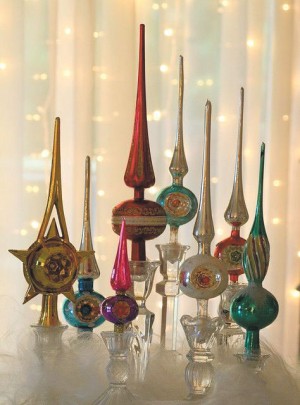There are those Christmas traditions that we automatically repeat year after year, just like our mothers before us and their mothers before them. But, did you ever wonder where these traditions got their start?
After several hours of “fluffing” our tree to add fullness, checking all the lights, stuffing the inner layer with sprigs of gold and poinsettias and then finding a place for my dozens of favorite ornaments, I stepped back to decide what to use this year for a tree topper. That is when it hit me . . . why do we feel the need to put something on top of the tree?
The tradition of the tree topper is believed by many to have started during the Renaissance in Germany in the early 16th century when a statue of the baby Jesus was placed on top of the tree. With the passage of time both stars and angels became more common. The 8-pointed “Star of Bethlehem,” also known a the “Christmas Star” represented the star recorded in the Gospel of Matthew, which led the wise men to the birthplace of Jesus. The angel also comes from the Bible and is said to be Gabriel, the angel who appeared to the Virgin Mary to tell her of the impending birth of the Christ Child.
Toppers were catapulted into popularity when the 1848 Christmas issue of “London Illustrated News” printed an engraving on their cover featuring Queen Victoria, Prince Albert and their children decorating a Christmas tree in Windsor Castle. Queen Victoria was quite popular with her subjects who were quick to imitate the use of tree toppers, an action that was soon copied by the affluent in America.
Dating early tree toppers is aided by the material from which they are made. Very early angels often had wings made of paper and lace surrounded by cotton balls to represent clouds. The more expensive of these will have a porcelain head and a hairstyle befitting the era of production. Stars are more difficult to date but tend to be very ornate when from the Victorian era, with more simplistic designs as they approach the early 1900s. Early stars are mostly made of metal or paper and will often have a picture of an angel in the center. Most tree ornaments and topper before 1940 were made in Germany and may be marked as such.
In addition to angels and stars you will also find finial tree toppers from the last half of the19th century forward. The most valuable of these are made of spun glass with silvered or lacquered spheres. Before the manufacture of Christmas ornaments became common in the U.S., these toppers were imported from the oldest Christmas ornament company in the world, Inge-Glas of Lauscha, Germany. Import to the U.S. was strong throughout the 1800s and well into the first quarter of the 20th century. These toppers were extremely delicate and few survived. When you do find them they will come with a premium price.
In 1937 Max Eckardt founded Shiny Brite Ornaments and by 1950 production had risen to over 1,000 ornaments a minute. Working in conjunction with Corning Glass, Shiny Brite grew to be the largest manufacturers of ornaments and tree toppers in the U.S. Many of their creations were sold through Woolworth’s Five-and-Ten Cent Stores and you will often find one of these mercury glass toppers in its original brown and green cardboard box with the Woolworth’s price tag still attached. Shiny Brite toppers 1950-1960 are currently trending, making this a great time to sell those you aren’t using.
Novice collectors often confuse the Christopher Radko designs of the late 1990s for original Shiny Brite ornaments. These are of little to no interest to serious collectors, so exercise caution when buying. Until next time . . . Linda
Linda Kennett is a professional liquidation consultant specializing in down-sizing for seniors and the liquidation of estates and may be reached at 317-258-7835 or lkennett@indy.rr.com.



